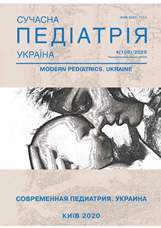Клінічний протокол медичної допомоги дітям із коронавірусною інфекцією (COVID-19), яка перебігає на фоні хронічних соматичних захворювань
Keywords:
COVID-19-інфекція, діагностика, фонові хронічні соматичні захворювання, лікування, дітиAbstract
У рамках протоколу узагальнено клінічні рекомендації щодо діагностики і лікування дітей з коронавірусною інфекцією COVID-19, яка перебігає на тлі різних хронічних соматичних захворювань. В основу протоколу покладено матеріали багатьох іноземних рекомендаційних документів, а також останнього вітчизняного протоколу щодо виявлення терапії коронавірусної інфекції, яка викликана COVID-19 (наказ МОЗ України від 20.05.2020 №1227). Відображено аспекти класифікації ступеня тяжкості і факторів ризику тяжкого перебігу хвороби, до яких належать і фонові хронічні соматичні захворювання, що потребує індивідуалізованого підходу до лікування. Охарактеризовано діагностичні критерії цієї інфекції, а також відмінності клінічної симптоматики COVID-19 у дітей від клінічних проявів у дорослих. Окремо наведено дані про ускладнення дитячої інфекції COVID-19 — мультисистемний запальний синдром. Особливість протоколу — рекомендації щодо ведення дітей з інфекцією COVID-19, яка перебігає на фоні хвороб серцево-судинної системи (вроджених вад серця, порушень серцевого ритму і провідності, легеневої гіпертензії тощо), захворювань органів дихання (бронхіальної астми і бронхолегеневої дисплазії), ревматичних (ювенільних артритів, системних хвороб сполучної тканини і системних васкулітів з ураженням легень, варіантів хвороб, які потребують постійної терапії глюкокортикоїдами або перебігають на тлі цукрового діабету) та інших аутоімунних захворювань (аутоімунного гепатиту, гломерулонефриту, особливо з хронічною недостатністю функції печінки або нирок). Також наведено рекомендації щодо ведення дітей, в яких COVID-19 розвинулася на фоні хвороб нирок і сечовидільної системи, ендокринних захворювань (цукрового діабету І типу, патології щитоподібної залози та наднирників), хвороб онкологічного і гематологічного генезу, у тому числі в стані імуносупресії.
References
p>1. WHO. (2020, February 16—24). Report of the WHO-China Joint Mission on Coronavirus Disease 2019 (COVID-19). URL: who.int/docs/default-source/coronaviruse/who-china-joint-mission-on-covid-19-final-report.pdf.
Lu X, Zhang L, Du H, Zhang J et al. (2020, April 23). SARS-CoV-2 Infection in Children. N Engl J Med. 382: 1663–1665; published on March 18, 2020, at NEJM.org. https://doi.org/10.1056/NEJMc2005073; PMid:32187458 PMCid:PMC7121177.
Dong Y, Mo X, Hu Y et al. (2020, June 1). Epidemiology of COVID-19 Among Children in China. Pediatrics. 145 (6). https://doi.org/10.1542/peds.2020-0702; PMid:32179660.
European Centre for Disease Prevention and Control. (2020, March 12). Infection prevention and control for COVID-19 in healthcare settings first update. Technical report. URL: ecdc.europa.eu/sites/default/files/documents/COVID-19-infection-prevention-and-control-healthcare-settings-march-2020.pdf. https://doi.org/10.7748/cnp.19.3.12.s9
WHO. (2019). Coronavirus disease (COVID-19) technical guidance: Infection prevention and control. URL: who.int/emergencies/diseases/novel-coronavirus-2019/technical-guidance/infection-prevention-and-control.
WHO. (2020, March 20). Global Surveillance for human infection with coronavirus disease (COVID-19). URL: who.int/publications-detail/global-surveillance-for-human-infection-with-novel-coronavirus-(2019-ncov).
ICD-10 Version: 2019. (2019). COVID-19, virus identified. URL: icd.who.int/browse10/2019/en#/U07.1
WHO. (2020, May 27). Clinical management of COVID-19. Clinical management of severe acute respiratory infection (SARI) when COVID-19 disease is suspected. Іnterim guidance on 13 March 2020. URL: who.int/publications-detail/clinical-management-of-severe-acute-respiratory-infection-when-novel-coronavirus-(ncov)-infection-is-suspected.
Gautret P, Lagier J-C, Parola Ph, Raoult D et al. (2020, March 20). Hydroxychloroquine and azithromycin as a treatment of COVID-19: results of an open-label non-randomized clinical trial. International Journal of Antimicrobial Agents. https://doi.org/10.1016/j.ijantimicag.2020.105949; PMid:32205204 PMCid:PMC7102549.
Zimmermann P, Nigel C. (2020, May). Coronavirus Infections in Children Including COVID-19. An Overview of the Epidemiology, Clinical Features, Diagnosis, Treatment and Prevention Options in Children. The Pediatric Infectious Disease Journal. 39 (5): 355–368. Accessed March 12, 2020. https://doi.org/10.1097/INF.0000000000002660; PMid:32310621 PMCid:PMC7158880.
Genentech. (2020, March 18). Genentech Initiates Phase III Clinical Trial Of Actemra In Hospitalized Patients With Severe COVID-19 Pneumonia. URL: https://www.gene.com/media/press-releases/14841/2020-03-18/genentech-initiates-phase-iii-clinical-t
EAHP. (2020, May). EAHP COVID-19 Resource Centre. URL: eahp.eu/hp-practice/hospital-pharmacy/eahp-covid-19-resource-centre.
Spanish Society of Hospital Pharmacy. (2020, March 19). Hospital pharmacy procedures for the management of antiviral treatment in the new coronavirus sars-cov-2 disease covid-19. URL: eahp.eu/sites/default/files/hospital_pharmacy_procedures_covid-19_march19th.pdf.
European Centre for Disease Prevention and Control. (2020). Novel coronavirus (SARS-CoV-2). Technical report. Discharge criteria for confirmed COVID-19 cases — When is i tsafe to discharge COVID-19 cases from the hospital or end home isolation? URL: ecdc.europa.eu/sites/default/files/documents/COVID-19-Discharge-criteria.pdf.
Chen Y, Li L. (2020, May). SARS-CoV-2: virus dynamics and host response. The Lancet Infectious Diseases. 20 (5). Published: March 23, 2020. https://doi.org/10.1016/S1473-3099(20)30235-8.
WHO. (2019). Country & Technical Guidance — Coronavirus disease (COVID-19). Laboratory testing for 2019-nCoV in humans. URL: who.int/emergencies/diseases/novel-coronavirus-2019/technical-guidance/laboratory-guidance.
Wang XF, Yuan J, Zheng YJ, Chen J, Bao YM, Wang YR, Wang LF, Li H, Zeng JX, Zhang YH, Liu YX, Liu L. (2020, February 17). Retracted: Clinical and Epidemiological Characteristics of 34 Children With 2019 Novel Coronavirus Infection in Shenzhen. 58 (0): 008. doi: 10.3760/cma.j.issn.0578-1310.2020.0008. URL: https://pub-med.ncbi.nlm.nih.gov/32062875/
Prise en charge a l'hopital des enfants atteints de COVID-19. (2020, March 31). Recommandations pour le traitement des enfants atteints de COVID-19. Belgian Pediatric Covid-19 Task Force. URL: http://gbs-vbs.org/fileadmin/user_upload/Unions/PED/Belg_Recomm_COVID_ped_31mar_FR.pdf
BPAIIG. (2020, April). BPAIIG Position Statement: Sars-CoV-2 Treatment Guidance. Position Statement: Management of novel coronavirus (SARS-CoV-2) infection in pediatric patients in the UK and Ireland. URL: https://www.bpaiig.org/sites/default/files/National_paediatric_COVID19%20treatment%20v1.2_0.pdf
Downloads
Published
Issue
Section
License
The policy of the Journal “MODERN PEDIATRICS. UKRAINE” is compatible with the vast majority of funders' of open access and self-archiving policies. The journal provides immediate open access route being convinced that everyone – not only scientists - can benefit from research results, and publishes articles exclusively under open access distribution, with a Creative Commons Attribution-Noncommercial 4.0 international license (СС BY-NC).
Authors transfer the copyright to the Journal “MODERN PEDIATRICS. UKRAINE” when the manuscript is accepted for publication. Authors declare that this manuscript has not been published nor is under simultaneous consideration for publication elsewhere. After publication, the articles become freely available on-line to the public.
Readers have the right to use, distribute, and reproduce articles in any medium, provided the articles and the journal are properly cited.
The use of published materials for commercial purposes is strongly prohibited.

